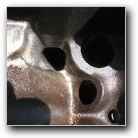|
Low Budget 350 Chev - Page 1
Introduction (Project
commenced October 2003)
This would have to be one of the lowest budget buildups
that will end up in an modified altered T-Bucket and hopefully will run
reasonable numbers for a season or two if I am lucky.
It will be assembled using parts sourced from swap meets,
leftovers from days gone bye and bits salvaged from the scrap heap.
Professional engine builders need not read any further
unless you want to find out how NOT to build an engine. The plan is to
get enough horsepower out of it to drop my et's enough to run in the 9
second range without busting the wallet, and if lucky, without even opening
the wallet :) (NOTE: The engine is now in the altered and has run 9.6s
on it's first outing and the second meet it ran 9.4s! - April 2003)
One thing to remember I am a Plumber by trade and not
a mechanic or engine builder. I do intend to build the engine with no
assistance other than with the machinist work.
At the very least you may have a laugh reading this
site, better still some exercise shaking your head in disgust..
As I obtain parts and assemble the engine I will add
to this page including some pics as I go.
The Block
I obtained a 350 Chev two bolt block (010) that had
a crack in the water jacket in the valley area just above the lifter bores.
The price was good (free) as it was ready for the scrap heap. It had been
sitting for some time and had rusted around the timing cover area.
I took it into the local machinist shop and asked the
easiest way to see how bad the crack was as it was almost invisible. He
applied an electromagnet to the area and dusted the valley with a red
powder and then some rusty liquid while I waited. The "crack"
turned out to be 3 cracks and appeared as though they were from a cooling
(or overheating) problem. Most likely from a cold area and the coolant
had probably frozen. The first option was the bin, second would be to
use a lock & stitch system which, due to the length of the cracks
would cost more than a reconditioned block. We marked the ends of the
cracks with a centre pop so I could later drill a small hole to prevent
the crack from spreading.
My idea was to grout fill the block to the bottom of
the water pump entry ports at the front of the block, thus preventing
coolant getting down to the cracks. As I use alcohol fuel in the current
engine (307 Chev) and have trouble keeping enough heat in the engine between
rounds I don't think overheating will be a problem. The grout filling
may help give the block some additional structural support as well.
I dropped the block to a local engine builder to get
checked what oversize it would need to be bored to. It measured up at
.020 and he said the condition was probably good enough to hone and drop
in new .020 pistons. Since either way I needed new pistons I opted to
bore it to .030 and proceeded to search the trusty net for piston info
and specs. I also searched for info on grouts and expansion rates etc.
and found the grout used under steel columns to be high strength and non
shrinking. Just what I needed..
I contacted the local building supply shop and inquired
about the grout. The stuff found on the net was not available out of the
warehouse here in AU but the distributor suggested another product that
had similar qualities and to my surprise sent a 20kg sample bag for me
to try for free. That something you don't come across too often these
days so I will mention the product is Ormonoid DuraGrout manufactured
by Davco a tiling glue and grout company here in Australia. Another plug
for them is that I used their rubber based tile glues and their tile grouts
when renovating our home and am quite happy with them.
Time to order pistons...

One of the oil drainback holes in the valley.
This one has been cleaned up with a rotary
file and will have a screen epoxied in place
before final assembly.
|

